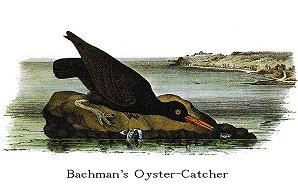
| Family XXXV. CHARADRIINAE. PLOVERS. GENUS IV. HAEMATOPUS. OYSTER-CATCHER. |
Next >> |

Family |
BACHMAN'S OYSTER-CATCHER. [American Black Oystercatcher (see also Townsend's Oyster-Catcher).] |
| Genus | HAEMATOPUS BACHMANI, Aud. [Haematopus bachmani.] |
According to my friend Mr. TOWNSEND, this species is abundant along the
whole of the north-west coast of America, as well as in Regent's Sound, but is
rarely seen on the shores within Cape Disappointment. The specimen sent to me
by him is ticketed as a male, shot in June 1836; but as in this genus there is
no difference as to colour between the male and the female, it may be supposed
that in this case the female differs only in being somewhat smaller.
The discovery of two new species is very remarkable, especially when it is
seen that not one of our three Oyster-catchers resembles the Haematopus
Ostralegus of Europe, which for a long time was supposed to exist in America, on
account of the figure given of this latter bird by WILSON, who must have taken
it from a stuffed European specimen in PEALE's Museum in Philadelphia. Whether
this be the case or not, it is pretty certain that no such bird as WILSON has
represented has as yet been observed in any part of North America, although some
writers have gone so far as to say so, without however offering any evidence.
BACHMAN's OYSTER-CATCHER, Haematopus Bachmani, Aud. Orn. Biog., vol. v.p. 245.
Male, 17 1/2, wing 10; bill 2 3/4.
North-west coast, Regent's Sound, and about the mouth of the Columbia
river. Rather common. Migratory.
Male.
Bill long, slender but strong, straight, higher than broad at the base,
towards the end extremely compressed, terminating in a very thin wedge-shaped
point. Upper mandible with the dorsal line at the base straight and slightly
sloping, a little arched beyond the nostrils, then nearly straight and sloping
to the point, the ridge broad and flattened as far as the prominence, afterwards
very narrow, the sides sloping at the base, perpendicular towards the end, the
edges sharp and direct. Nasal groove basal, long; nostrils sub-basal, in the
middle of the groove near the margin, linear, direct, pervious. Lower mandible
with the angle rather short and narrow, the dorsal line straight and slightly
ascending, the ride narrow, the sides a little convex and erect, with a shallow
groove at the base, the edges sharp and direct.
Head of moderate size, ovate, the forehead convex. Neck rather long. Feet
of moderate length, rather stout; tibia bare for half an inch; tarsus rather
short, slightly compressed, covered all round with hexagonal scales; toes rather
short and fleshy, the hind toe wanting, the second shorter than the fourth, the
third considerably longer, all scaly at the base above, scutellate towards the
end, flattened and broad beneath, with thick margins, and connected at the base
by short webs, of which the outer is longer. Claws small, compressed at the
base, depressed and rounded at the end, that of the middle toe largest, with a
somewhat dilated thin inner edge.
Plumage of the head and neck short and blended, of the back rather compact
and slightly glossed, of the lower parts blended, the feathers in general ovate
and rounded. Wings long, acute; primaries tapering toward the end, but obtuse,
the first longest, the second one-twelfth of an inch shorter, the third
two-twelfths shorter than the second, the rest more rapidly graduated;
secondaries broad and rounded, the inner much elongated and tapering. Tail
short, nearly even, of twelve rather broad, rounded feathers, of which the
lateral are two-twelfths shorter than the middle (but as they are all worn the
proportions cannot be determined).
Bill vermilion, fading to yellow on the worn parts toward the end. Edges
of eyelids vermilion; iris yellow. Feet white, slightly tinged with
flesh-colour; claws yellowish, toward the end dusky. The plumage is
chocolate-brown, darker, and tinged with bluish-grey on the head and neck; the
under surface of the quills light brownish-grey, their shafts whitish.
Length to end of tail 17 1/2 inches; bill along the ridge 2 9/12, along the
edge of lower mandible 2 (10 1/2)/12, its greatest height beyond the nostrils
(6 1/4)/12; wing from flexure 10; tail 3 11/12; tarsus 1 (10 1/2)/12; inner toe
1, its claw 3/12; middle toe 1 (4 1/2)/12, its claw (4 1/4)/12; outer toe
1 2/12, its claw (2 3/4)/12.
| Next >> |